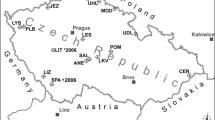Abstract
The Hubbard Brook Ecosystem Study was designed to evaluate element flux and cycling in a northern hardwood forest and the effects of disturbance on these processes. In the original experiment, an entire watershed was deforested and regrowth was inhibited for three years using herbicides. Initial effects of the treatment included: elevated stream discharge, large increases in streamwater solute concentrations and elevated losses of those ions from the watershed. In contrast, streamwater concentrations and net ecosystem output of sulfate decreased in response to the treatment. During the post treatment period, the concentrations of most dissolved ions declined relative to a reference watershed while, again in contrast, sulfate concentrations increased relative to the reference. In this paper we develop a hypothesis which links acidification and sulfate adsorption processes in the soil to explain the observed trends in sulfate losses from the Hubbard Brook Experimental Forest.
Similar content being viewed by others
References
Binkley, D. & D. Richter (1987) Nutrient cycles and hydrogen budgets of forest ecosystems. Advances in Ecological Research. 16: 1–51
Bormann, F.H. & G.E. Likens (1979) Pattern and process in a forested ecosystem. Springer-Verlag, New York Inc.
Chao, T.T., M.E. Harwood & S.F. Fang (1964) Iron or aluminum coatings in relation to sulfate adsorption characteristics of soils. Soil Science Society of America Proceedings 28: 632–635
Davies D.D. (1973) Control of and by pH. Symposium for the Society of Experimental Biology. 27: 513–529
Dominski, A.S. (1971) Accelerated nitrate production and loss in the northern hardwood forest ecosystem underlain by podsol soils following clearcutting and addition of herbicides. Ph.D. thesis, Yale University
Driscoll, C.T. & G.S. Schafran (1984) Characterization of short-term changes in the base neutralizing capacity of an acidic Adirondack New York Lake. Nature 310: 308–310
Driscoll, C.T., M. van Breemen & J. Mulder (1985) Aluminum chemistry in a forested Spodosol. Soil Science Society of America Journal 49: 437–444
Fuller R.D., M.D. David & C.T. Driscoll (1985) Sulfate adsorption relationships in some Northern Forest Spodosols, Soil Science Society of America Journal 49: 1034–1046
Fuller, R., C.T. Driscoll, G. Lawrence & S.C. Nodvin (1987) Processes regulating sulphate flux after whole-tree harvesting. Nature 325: 707–710
Henderson, G.S., W.T. Swank & J.W. Hornbeck (1980) Impact of sulfur deposition on the quality of water from forested watersheds. In: D.S. Shriner, C.R. Richmond & S.E. Lindberg (Eds) Atmospheric Sulfur Deposition. Environmental Impact and Health Effects (pp. 431–441). Ann Arbor Science
Higinbotham, N. (1973) The mineral absorption process in plants. Botanical Review 39: 15–69
Johnson, D.W & D.W. Cole (1980) Anion mobility in soils: Relevance to nutrient transport from forest ecosystems. Environment International 3: 79–80
Johnson, N.M., G.E. Likens, F.H. Bormann, D.W. Fisher & R.S. Pierce (1969) A working model for the variation in stream chemistry at the Hubbard Brook Experimental Forest. New Hampshire. Water Resources Research 5: 1353–1363
Johnson, N.M., C.T. Driscoll, J.S. Eaton, G.E. Likens & W.H. McDowell (1981) ‘Acid rain’, dissolved aluminum and chemical weathering at the Hubbard Brook Experimental Forest, New Hampshire. Geochimica Cosmochimica Acta 45: 1421–1437
Likens, G.E. & F.H. Bormann (1974) Effects of forest clearing on the northern hardwood forest ecosystem and its biogeochemistry. In: Proceedings of the First International Congress of Ecology, September 1974 (pp. 330–335). Centre of Agricultural Publications and Documentation. Wageningen, The Netherlands
Likens, G.E., F.H. Bormann & N.M. Johnson (1969) Nitrification importance to nutrient losses from a cutover forested ecosystem. Science 1673: 1205–1206
Likens, G.E., F.H. Bormann, N.M. Johnson, D.W. Fisher & R.S. Pierce (1970) Effects of forest cutting and herbicide treatment on nutrient budgets in the Hubbard Brook watershed-ecosystem. Ecological Monographs 40: 23–47
Likens, G.E., F.H. Bormann, R.S. Pierce, J.S. Eaton & N.M. Johnson (1977) Biogeochemistry of a forested ecosystem. Springer-Verlag, New York, Inc.
Likens, G.E., F.H. Bormann, R.S. Pierce & J.S. Eaton (1985) The Hubbard Brook Valley. In: G.E. Likens (Ed) An Ecosystem Approach to Aquatic Ecology. Mirror Lake and its Environment (pp. 9–39). Springer-Verlag, New York, Inc.
Likens, G.E., F.H. Bormann, R.S. Pierce & W.A. Reiners (1978) Recovery of a deforested ecosystem. Science 199: 492–496
Martin, C.W., D.S. Noel & C.A. Federer (1984) Effects of forest clearcutting in New England on stream chemistry. Journal of Environmental Quality 13: 204–120
Martin, C.W., R.S. Pierce, G.E. Likens & F.H. Bormann (1986) Clearcutting affects stream chemistry in the White Mountains of New Hampshire. USDA Forest Service, Northeastern Forest Experiment Station, Research Paper NE-579
Matzner, E. & B. Ulrich (1985) Implications for the chemical soil conditions for forest decline (1985) Experientia 41: 578–584
Melillo, J.M. (1977) Mineralization of nitrogen in northern forest ecosystems. Ph.D. Thesis, Yale University
Nodvin, S.C. (1983) Effects of disturbance on decomposition processes and on sulfur cycling in the northern hardwood forest. Ph.D. thesis, Cornell University
Nodvin, S.C., C.T. Driscoll & G.E. Likens (1986a) Simple partitioning of anions and dissolved organic carbon in a forest soil. Soil Science 142: 27–35
Nodvin, S.C., C.T. Driscoll & G.E. Likens (1986b) The effect of pH on sulfate adsorption in a forest soil. Soil Science 142: 69–75
Noggle, J.C. (1966) Ionic balance and growth of sixteen plant species. Soil Science Society of America Proceedings 30: 763–766
Parfitt, R.L. (1978) Anion adsorption by soils and soil mineral. Advances in Agronomy 30: 1–50
Rascher, C.M., C.T. Driscoll & N.E. Peters (1987) Concentration and flux of solutes from snow and forest floor during snowmelt in the West-Central Adirondack region of New York. Biogeochemistry 3: 209–224
Raven, J.A. & F.A. Smith (1974) Significance of hydrogen ion transport in plant cells. Canadian Journal of Botany 52: 1035–1048
Smith, W.H., F.H. Bormann & G.E. Likens (1968) Response of chemoautotrophic nitrifiers to forest cutting. Soil Science 106: 471–473
Tabatabai, M.A. & W.A. Dick (1983) Simultaneous determination of nitrate, chloride, sulfate, and phosphate in natural waters by ion chromatography. Journal of Environmental Quality 12: 209–213
Author information
Authors and Affiliations
Rights and permissions
About this article
Cite this article
Nodvin, S.C., Driscoll, C.T. & Likens, G.E. Soil processes and sulfate loss at the Hubbard Brook Experimental Forest. Biogeochemistry 5, 185–199 (1988). https://doi.org/10.1007/BF02180227
Issue Date:
DOI: https://doi.org/10.1007/BF02180227




